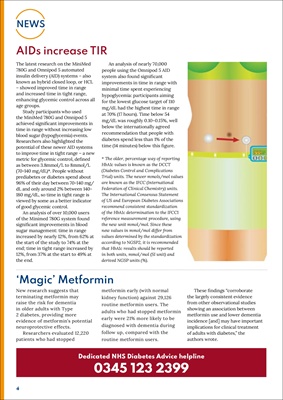
4
NEWS
Dedicated NHS Diabetes Advice helpline
0345 123 2399
AIDs increase TIR
The latest research on the MiniMed
780G and Omnipod 5 automated
insulin delivery (AID) systems - also
known as hybrid closed loop, or HCL
- showed improved time in range
and increased time in tight range,
enhancing glycemic control across all
age groups.
Study participants who used
the MiniMed 780G and Omnipod 5
achieved significant improvements in
time in range without increasing low
blood sugar (hypoglycemia) events.
Researchers also highlighted the
potential of these newer AID systems
to improve time in tight range - a
new metric for glycemic control,
defined as between 3.8mmol/L to
8mmol/L (70-140 mg/dL)*. People
without prediabetes or diabetes
spend about 96% of their day
between 70-140 mg/dL and only
around 2% between 140-180 mg/dL,
so time in tight range is viewed by
some as a better indicator of good
glycemic control.
An analysis of over 10,000 users
of the Minimed 780G system found
significant improvements in blood
sugar management: time in range
increased by nearly 12%, from 62% at
the start of the study to 74% at the
end; time in tight range increased by
12%, from 37% at the start to 49% at
the end.
An analysis of nearly 70,000
people using the Omnipod 5 AID
system also found significant
improvements in time in range with
minimal time spent experiencing
hypoglycemia: participants aiming
for the lowest glucose target of 110
mg/dL had the highest time in range
at 70% (17 hours). Time below 54
mg/dL was roughly 0.10-0.15%, well
below the internationally agreed
recommendation that people with
diabetes spend less than 1% of the
time (14 minutes) below this figure.
* The older, percentage way of reporting
HbA1c values is known as the DCCT
(Diabetes Control and Complications
Trial) units. The newer mmols/mol values
are known as the IFCC (International
Federation of Clinical Chemistry) units.
The International Consensus Statement
of US and European Diabetes Associations
recommend consistent standardization
of the HbA1c determination to the IFCC1
reference measurement procedure, using
the new unit mmol/mol. Since these
new values in mmol/mol differ from
values determined by the standardization
according to NGSP2, it is recommended
that HbA1c results should be reported
in both units, mmol/mol (SI unit) and
derived NGSP units (%).
'Magic' Metformin
New research suggests that
terminating metformin may
raise the risk for dementia
in older adults with Type
2 diabetes, providing more
evidence of metformin's potential
neuroprotective effects.
Researchers evaluated 12,220
patients who had stopped
metformin early (with normal
kidney function) against 29,126
routine metformin users. The
adults who had stopped metformin
early were 21% more likely to be
diagnosed with dementia during
follow up, compared with the
routine metformin users.
These findings "corroborate
the largely consistent evidence
from other observational studies
showing an association between
metformin use and lower dementia
incidence [and] may have important
implications for clinical treatment
of adults with diabetes," the
authors wrote.